► VW’s fourth bespoke EV concept
► Level 5 autonomous = no wheel
► Bi-motors, 302bhp, 0-62mph in 6.3sec
Volkswagen’s ID electric car branding feels amazingly well established already considering we’re not actually expecting the first production version until 2021. Now the 2018 Geneva motor show brings a fourth concept example, the super-sleek VW ID Vizzion.
The ID Vizzion follows the original the ID hatch (a kind of electric Golf substitute), the ID Crozz coupe-SUV and the ID Buzz van/MPV, and immediately establishes itself as a strong contender for the ID with the daftest name.
In terms of looks, the Vizzion is perhaps the least outlandish ID model yet – but with absolutely no hint of a steering wheel or pedals inside and lots of talk of artificial intelligence-led autonomous driving, it totally gets its futuristic mojo back when it comes to technology.
See all the new cars at the Geneva motor show here
Size is everything for the VW ID Vizzion
As a large four-door – or is it five-door? – coupe, the Vizzion looks like a natural progression of the current VW Arteon.
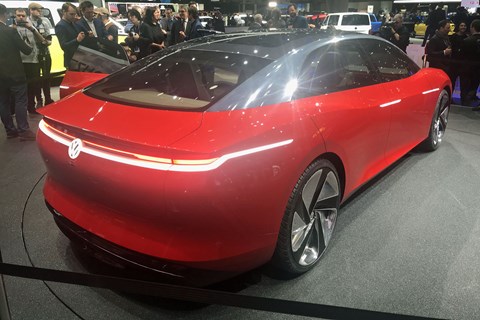
However, at nearly 5.2m long and 2.0m wide, it takes up quite a bit more pavement, and VW refers to this as an ‘elongated top model of the Phaeton class’, signalling its continuing luxury ambitions. The form-factor has clear resonance with the Tesla Model S as well.
As a guide to the scale of this thing, those are 24-inch wheels. The wheelbase is 3.1m and it’s just over 1.5m tall.
Other fun exterior features include VW’s pronouncement that ‘light is the new chrome’. You can see there are indeed loads of light-up elements on the outside, including the door handles.
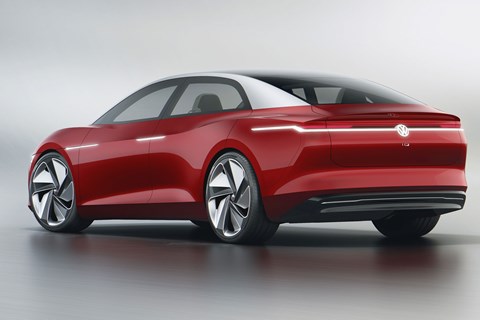
What’s less immediately obvious is that the Vizzion also features HD Matrix headlights with 8000 individual pixels, which can be used for communication as well as illuminiation, while the entire rear window is a giant OLED display that functions as a particularly attention-grabbing third brake light.
Love hertz: VW ID Buzz vs Mk1 Microbus twin test
Promise of significant power and driving range
The Vizzion uses a bespoke electric vehicle platform called MEB, just like the other VW ID models. In this instance you also get two motors, two gearboxes and a sizable 111kWh battery pack.
At the front axle there’s a 75kW coaxial drive – equivalent to 101bhp – and at the rear, what’s described as a ‘compact’ 150kW motor – equivalent to 201bhp. The combined 302bhp will no doubt be accompanied by an as yet un-quantified wodge of instant torque, enough at least for a claimed 6.3sec 0-62mph time.
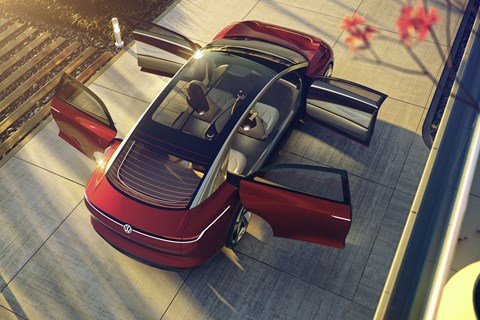
That battery pack not only outsizes Tesla’s current 100kWh max, it’s also very nearly three times the capacity of that fitted in the second-generation Nissan Leaf. VW reckons the Vizzion will therefore cover 413 miles between charges – although that is according to the soon-to-be-replaced NEDC test cycle.
According to Volkswagen the ‘ideal method for charging the battery is over an inductive interface’ – meaning the Vizzion has wireless charging capability. But since we’re yet to see this technology deliver a meaningful charging speed without an intensity that would also present a grave threat to passing wildlife, regular cable charging is available, too.
Top speed is limited to 112mph – which doesn’t sound like much but that is exclusively under Level 5 autonomous control…
Steering wheels are so 2017
You’ll have noticed the Vizzion doesn’t have a steering wheel – or pedals. For in addition to being an electric car this is a statement of VW’s autonomous driving intent, designed for Level 5 self-driving mobility where such antiquated devices are no longer required.
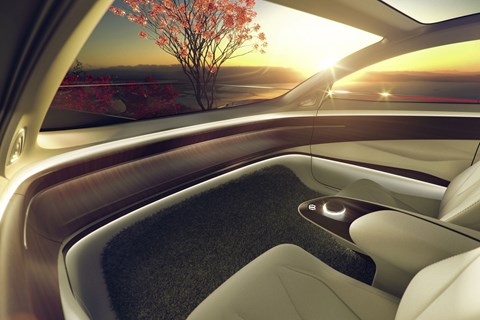
VW also reckons we’ll be at this stage by 2025 – although it’s hedging a bit to suggest that some of the Vizzion’s augmented reality control concepts – which use Microsoft HoloLens technology to project a virtual interface – won’t be ready until 2030.
Slightly more conventional voice or smart device control systems are also present, however, so don’t worry if you’ve left your HoloLens at home when you visit the Geneva show.
The self-learning car
Beyond this, VW suggests that when 2025 rolls around, cars like the Vizzion will use artificial intelligence to adapt to its ‘users’, becoming ‘your digital assistant’ for everyday life. This is less car, more device.
At a basic level, this will mean instead of you telling it your preferences, the car will figure them out – from your favourite music to your preferred seating position and air-conditioning settings. This isn’t especially farfetched, as some current infotainment systems have a little of this functionality already.
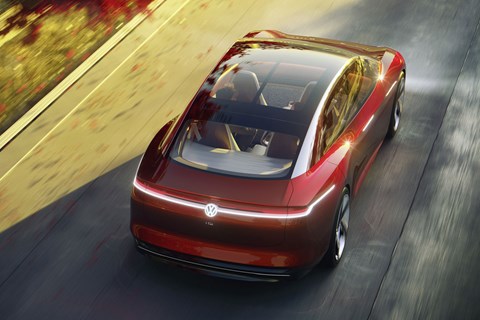
More significantly, this self-learning ability is intended to enable the car to drive itself better, turning the Vizzion into what VW calls an ‘intelligent chauffeur’.
We’d better hope it’s intelligent, as there really isn’t a steering wheel to affect any kind of passenger mutiny.
Futuristic safety tech and making you feel at home
From facial recognition technology that will prevent it from being stolen to utilising the HD Matrix headlights to project a zebra crossing onto the road to signal safe passage for pedestrians, the Vizzion is also big on safety innovation.
Stopping idiots like us from driving the car by implementing Level 5 will still be the biggest factor in preventing accidents in the future, though, VW understandably reckons.
Further techy titbits include variable-tint glass (like a Boeing 787 Dreamliner) and fitness monitor integration to make sure you don’t keel over with boredom while sitting looking at Facebook in your mobile lounge – or indeed overheat, as the car will also use this data to modulate the air-con.
The future’s coming people, and we aren’t going to be driving it…
VW is hoping its cars are the ones you’ll be sitting in, though. And by 2025 the company expects to have 15 cars sitting on the electricifed MEB platform, and to be producing one million EVs, too.
Check out our VW reviews
